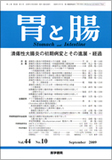Japanese
English
- 有料閲覧
- Abstract 文献概要
- 1ページ目 Look Inside
- 参考文献 Reference
- サイト内被引用 Cited by
要旨 患者は80歳代,男性.主訴は便潜血陽性.大腸内視鏡検査で直腸Raに10mm大のIs+IIc病変を認めた.クリスタルバイオレット染色による拡大観察では,隆起の立ち上がりはIIIL~IV型pit pattern,陥凹局面はVI型pit pattern(高度不整)で,NBI拡大観察では陥凹局面は不整な微小血管を認め,血管分布は不均一で無血管野も出現しており,SM深部浸潤を示唆する所見であったが,そのほか明らかなSM深部浸潤の所見は認めなかったため,total biopsy目的でEMRを施行した.病理組織結果は,中分化型管状腺癌,SM実測値1,180μm(粘膜筋板は消失し病巣表層から測定),脈管侵襲ly0,v0,水平断端,深部断端陰性であった.
An eighty-year-old male underwent colonoscopy for the diagnosis of the reason for occult blood in his stool. Conventional colonoscopy revealed a protruded lesion with an irregular central depressed area in the upper rectum. The tumor was 10mm in diameter, and the gross configuration was type Is+IIc. Magnifying colonoscopy with crystal violet showed IIIL~IV type pit pattern in the prominent border and VI-high type pit pattern in the depressed area. Magnifying colonoscopy using the narrow band imaging(NBI)system showed thick and irregular vessels and disrupted capillary pattern in the depressed area. Based on this finding, this tumor was diagnosed as being submucosal invasive carcioma. Endoscopic mucosal resection(EMR)was performed to bring about total biopsy. Histologically, the depressed lesion was a moderately differentiated adenocarcinoma with the depth of submucosal invasion being(SM 1,180μm), ly0, v0.
This case was diagnosed using the NBI system, more effectively than with the barium enema or the pit pattern method.

Copyright © 2009, Igaku-Shoin Ltd. All rights reserved.


